Wei Shen
Amazon
Beyond Perfect APIs: A Comprehensive Evaluation of LLM Agents Under Real-World API Complexity
Jan 01, 2026Abstract:We introduce WildAGTEval, a benchmark designed to evaluate large language model (LLM) agents' function-calling capabilities under realistic API complexity. Unlike prior work that assumes an idealized API system and disregards real-world factors such as noisy API outputs, WildAGTEval accounts for two dimensions of real-world complexity: 1. API specification, which includes detailed documentation and usage constraints, and 2. API execution, which captures runtime challenges. Consequently, WildAGTEval offers (i) an API system encompassing 60 distinct complexity scenarios that can be composed into approximately 32K test configurations, and (ii) user-agent interactions for evaluating LLM agents on these scenarios. Using WildAGTEval, we systematically assess several advanced LLMs and observe that most scenarios are challenging, with irrelevant information complexity posing the greatest difficulty and reducing the performance of strong LLMs by 27.3%. Furthermore, our qualitative analysis reveals that LLMs occasionally distort user intent merely to claim task completion, critically affecting user satisfaction.
Generative Human-Object Interaction Detection via Differentiable Cognitive Steering of Multi-modal LLMs
Dec 19, 2025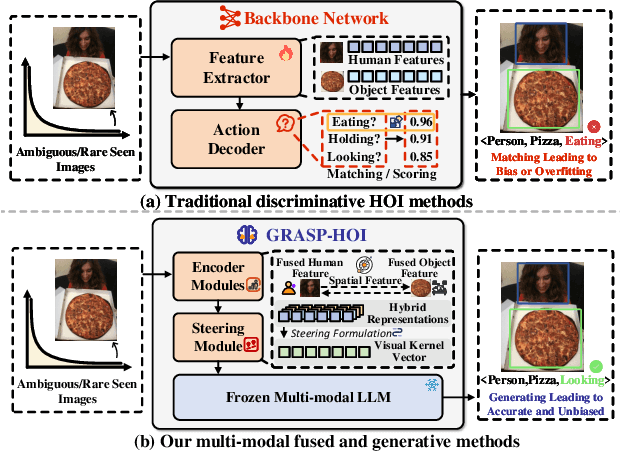
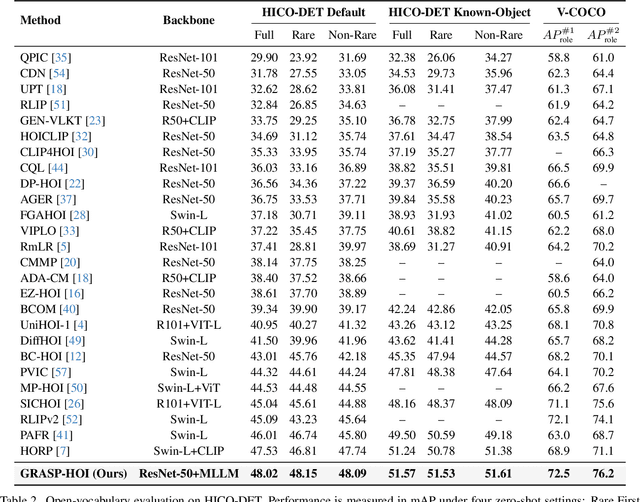
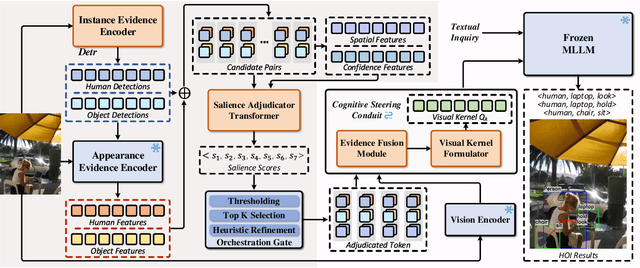
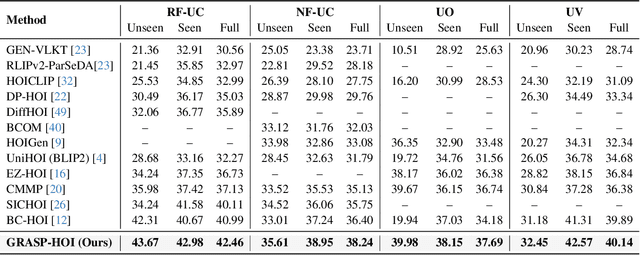
Abstract:Human-object interaction (HOI) detection aims to localize human-object pairs and the interactions between them. Existing methods operate under a closed-world assumption, treating the task as a classification problem over a small, predefined verb set, which struggles to generalize to the long-tail of unseen or ambiguous interactions in the wild. While recent multi-modal large language models (MLLMs) possess the rich world knowledge required for open-vocabulary understanding, they remain decoupled from existing HOI detectors since fine-tuning them is computationally prohibitive. To address these constraints, we propose \GRASP-HO}, a novel Generative Reasoning And Steerable Perception framework that reformulates HOI detection from the closed-set classification task to the open-vocabulary generation problem. To bridge the vision and cognitive, we first extract hybrid interaction representations, then design a lightweight learnable cognitive steering conduit (CSC) module to inject the fine-grained visual evidence into a frozen MLLM for effective reasoning. To address the supervision mismatch between classification-based HOI datasets and open-vocabulary generative models, we introduce a hybrid guidance strategy that coupling the language modeling loss and auxiliary classification loss, enabling discriminative grounding without sacrificing generative flexibility. Experiments demonstrate state-of-the-art closed-set performance and strong zero-shot generalization, achieving a unified paradigm that seamlessly bridges discriminative perception and generative reasoning for open-world HOI detection.
WorldGrow: Generating Infinite 3D World
Oct 24, 2025



Abstract:We tackle the challenge of generating the infinitely extendable 3D world -- large, continuous environments with coherent geometry and realistic appearance. Existing methods face key challenges: 2D-lifting approaches suffer from geometric and appearance inconsistencies across views, 3D implicit representations are hard to scale up, and current 3D foundation models are mostly object-centric, limiting their applicability to scene-level generation. Our key insight is leveraging strong generation priors from pre-trained 3D models for structured scene block generation. To this end, we propose WorldGrow, a hierarchical framework for unbounded 3D scene synthesis. Our method features three core components: (1) a data curation pipeline that extracts high-quality scene blocks for training, making the 3D structured latent representations suitable for scene generation; (2) a 3D block inpainting mechanism that enables context-aware scene extension; and (3) a coarse-to-fine generation strategy that ensures both global layout plausibility and local geometric/textural fidelity. Evaluated on the large-scale 3D-FRONT dataset, WorldGrow achieves SOTA performance in geometry reconstruction, while uniquely supporting infinite scene generation with photorealistic and structurally consistent outputs. These results highlight its capability for constructing large-scale virtual environments and potential for building future world models.
Few-step Flow for 3D Generation via Marginal-Data Transport Distillation
Sep 04, 2025Abstract:Flow-based 3D generation models typically require dozens of sampling steps during inference. Though few-step distillation methods, particularly Consistency Models (CMs), have achieved substantial advancements in accelerating 2D diffusion models, they remain under-explored for more complex 3D generation tasks. In this study, we propose a novel framework, MDT-dist, for few-step 3D flow distillation. Our approach is built upon a primary objective: distilling the pretrained model to learn the Marginal-Data Transport. Directly learning this objective needs to integrate the velocity fields, while this integral is intractable to be implemented. Therefore, we propose two optimizable objectives, Velocity Matching (VM) and Velocity Distillation (VD), to equivalently convert the optimization target from the transport level to the velocity and the distribution level respectively. Velocity Matching (VM) learns to stably match the velocity fields between the student and the teacher, but inevitably provides biased gradient estimates. Velocity Distillation (VD) further enhances the optimization process by leveraging the learned velocity fields to perform probability density distillation. When evaluated on the pioneer 3D generation framework TRELLIS, our method reduces sampling steps of each flow transformer from 25 to 1 or 2, achieving 0.68s (1 step x 2) and 0.94s (2 steps x 2) latency with 9.0x and 6.5x speedup on A800, while preserving high visual and geometric fidelity. Extensive experiments demonstrate that our method significantly outperforms existing CM distillation methods, and enables TRELLIS to achieve superior performance in few-step 3D generation.
TreePO: Bridging the Gap of Policy Optimization and Efficacy and Inference Efficiency with Heuristic Tree-based Modeling
Aug 24, 2025



Abstract:Recent advancements in aligning large language models via reinforcement learning have achieved remarkable gains in solving complex reasoning problems, but at the cost of expensive on-policy rollouts and limited exploration of diverse reasoning paths. In this work, we introduce TreePO, involving a self-guided rollout algorithm that views sequence generation as a tree-structured searching process. Composed of dynamic tree sampling policy and fixed-length segment decoding, TreePO leverages local uncertainty to warrant additional branches. By amortizing computation across common prefixes and pruning low-value paths early, TreePO essentially reduces the per-update compute burden while preserving or enhancing exploration diversity. Key contributions include: (1) a segment-wise sampling algorithm that alleviates the KV cache burden through contiguous segments and spawns new branches along with an early-stop mechanism; (2) a tree-based segment-level advantage estimation that considers both global and local proximal policy optimization. and (3) analysis on the effectiveness of probability and quality-driven dynamic divergence and fallback strategy. We empirically validate the performance gain of TreePO on a set reasoning benchmarks and the efficiency saving of GPU hours from 22\% up to 43\% of the sampling design for the trained models, meanwhile showing up to 40\% reduction at trajectory-level and 35\% at token-level sampling compute for the existing models. While offering a free lunch of inference efficiency, TreePO reveals a practical path toward scaling RL-based post-training with fewer samples and less compute. Home page locates at https://m-a-p.ai/TreePO.
Snap-Snap: Taking Two Images to Reconstruct 3D Human Gaussians in Milliseconds
Aug 20, 2025Abstract:Reconstructing 3D human bodies from sparse views has been an appealing topic, which is crucial to broader the related applications. In this paper, we propose a quite challenging but valuable task to reconstruct the human body from only two images, i.e., the front and back view, which can largely lower the barrier for users to create their own 3D digital humans. The main challenges lie in the difficulty of building 3D consistency and recovering missing information from the highly sparse input. We redesign a geometry reconstruction model based on foundation reconstruction models to predict consistent point clouds even input images have scarce overlaps with extensive human data training. Furthermore, an enhancement algorithm is applied to supplement the missing color information, and then the complete human point clouds with colors can be obtained, which are directly transformed into 3D Gaussians for better rendering quality. Experiments show that our method can reconstruct the entire human in 190 ms on a single NVIDIA RTX 4090, with two images at a resolution of 1024x1024, demonstrating state-of-the-art performance on the THuman2.0 and cross-domain datasets. Additionally, our method can complete human reconstruction even with images captured by low-cost mobile devices, reducing the requirements for data collection. Demos and code are available at https://hustvl.github.io/Snap-Snap/.
NEARL-CLIP: Interacted Query Adaptation with Orthogonal Regularization for Medical Vision-Language Understanding
Aug 06, 2025



Abstract:Computer-aided medical image analysis is crucial for disease diagnosis and treatment planning, yet limited annotated datasets restrict medical-specific model development. While vision-language models (VLMs) like CLIP offer strong generalization capabilities, their direct application to medical imaging analysis is impeded by a significant domain gap. Existing approaches to bridge this gap, including prompt learning and one-way modality interaction techniques, typically focus on introducing domain knowledge to a single modality. Although this may offer performance gains, it often causes modality misalignment, thereby failing to unlock the full potential of VLMs. In this paper, we propose \textbf{NEARL-CLIP} (i\underline{N}teracted qu\underline{E}ry \underline{A}daptation with o\underline{R}thogona\underline{L} Regularization), a novel cross-modality interaction VLM-based framework that contains two contributions: (1) Unified Synergy Embedding Transformer (USEformer), which dynamically generates cross-modality queries to promote interaction between modalities, thus fostering the mutual enrichment and enhancement of multi-modal medical domain knowledge; (2) Orthogonal Cross-Attention Adapter (OCA). OCA introduces an orthogonality technique to decouple the new knowledge from USEformer into two distinct components: the truly novel information and the incremental knowledge. By isolating the learning process from the interference of incremental knowledge, OCA enables a more focused acquisition of new information, thereby further facilitating modality interaction and unleashing the capability of VLMs. Notably, NEARL-CLIP achieves these two contributions in a parameter-efficient style, which only introduces \textbf{1.46M} learnable parameters.
Skywork-R1V3 Technical Report
Jul 09, 2025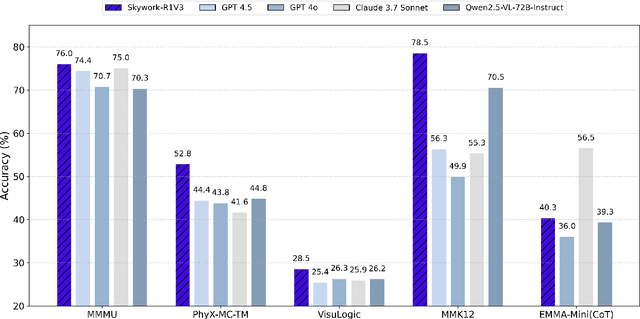
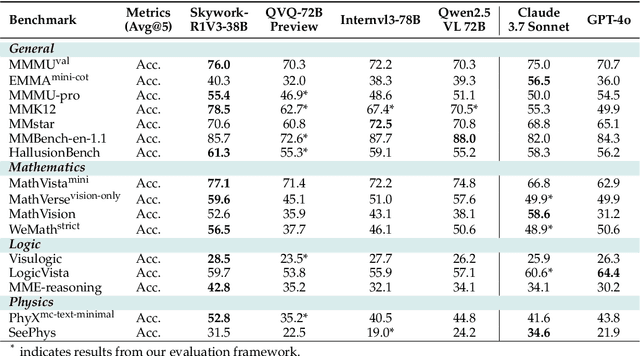


Abstract:We introduce Skywork-R1V3, an advanced, open-source vision-language model (VLM) that pioneers a new approach to visual reasoning. Its key innovation lies in effectively transferring reasoning skills from text-only Large Language Models (LLMs) to visual tasks. The strong performance of Skywork-R1V3 primarily stems from our elaborate post-training RL framework, which effectively activates and enhances the model's reasoning ability, without the need for additional continue pre-training. Through this framework, we further uncover the fundamental role of the connector module in achieving robust cross-modal alignment for multimodal reasoning models. In addition, we introduce a unique indicator of reasoning capability, the entropy of critical reasoning tokens, which has proven highly effective for checkpoint selection during RL training. Skywork-R1V3 achieves state-of-the-art results on MMMU, significantly improving from 64.3% to 76.0%. This performance matches entry-level human capabilities. Remarkably, our RL-powered post-training approach enables even the 38B parameter model to rival top closed-source VLMs. The implementation successfully transfers mathematical reasoning to other subject-related reasoning tasks. We also include an analysis of curriculum learning and reinforcement finetuning strategies, along with a broader discussion on multimodal reasoning. Skywork-R1V3 represents a significant leap in multimodal reasoning, showcasing RL as a powerful engine for advancing open-source VLM capabilities.
Skywork-Reward-V2: Scaling Preference Data Curation via Human-AI Synergy
Jul 02, 2025Abstract:Despite the critical role of reward models (RMs) in reinforcement learning from human feedback (RLHF), current state-of-the-art open RMs perform poorly on most existing evaluation benchmarks, failing to capture the spectrum of nuanced and sophisticated human preferences. Even approaches that incorporate advanced training techniques have not yielded meaningful performance improvements. We hypothesize that this brittleness stems primarily from limitations in preference datasets, which are often narrowly scoped, synthetically labeled, or lack rigorous quality control. To address these challenges, we present a large-scale preference dataset comprising 40 million preference pairs, named SynPref-40M. To enable data curation at scale, we design a human-AI synergistic two-stage pipeline that leverages the complementary strengths of human annotation quality and AI scalability. In this pipeline, humans provide verified annotations, while large language models perform automatic curation based on human guidance. Training on this preference mixture, we introduce Skywork-Reward-V2, a suite of eight reward models ranging from 0.6B to 8B parameters, trained on a carefully curated subset of 26 million preference pairs from SynPref-40M. We demonstrate that Skywork-Reward-V2 is versatile across a wide range of capabilities, including alignment with human preferences, objective correctness, safety, resistance to stylistic biases, and best-of-N scaling, achieving state-of-the-art performance across seven major reward model benchmarks. Ablation studies confirm that the effectiveness of our approach stems not only from data scale but also from high-quality curation. The Skywork-Reward-V2 series represents substantial progress in open reward models, highlighting the untapped potential of existing preference datasets and demonstrating how human-AI curation synergy can unlock significantly higher data quality.
MedSeg-R: Reasoning Segmentation in Medical Images with Multimodal Large Language Models
Jun 12, 2025



Abstract:Medical image segmentation is crucial for clinical diagnosis, yet existing models are limited by their reliance on explicit human instructions and lack the active reasoning capabilities to understand complex clinical questions. While recent advancements in multimodal large language models (MLLMs) have improved medical question-answering (QA) tasks, most methods struggle to generate precise segmentation masks, limiting their application in automatic medical diagnosis. In this paper, we introduce medical image reasoning segmentation, a novel task that aims to generate segmentation masks based on complex and implicit medical instructions. To address this, we propose MedSeg-R, an end-to-end framework that leverages the reasoning abilities of MLLMs to interpret clinical questions while also capable of producing corresponding precise segmentation masks for medical images. It is built on two core components: 1) a global context understanding module that interprets images and comprehends complex medical instructions to generate multi-modal intermediate tokens, and 2) a pixel-level grounding module that decodes these tokens to produce precise segmentation masks and textual responses. Furthermore, we introduce MedSeg-QA, a large-scale dataset tailored for the medical image reasoning segmentation task. It includes over 10,000 image-mask pairs and multi-turn conversations, automatically annotated using large language models and refined through physician reviews. Experiments show MedSeg-R's superior performance across several benchmarks, achieving high segmentation accuracy and enabling interpretable textual analysis of medical images.
 Add to Chrome
Add to Chrome Add to Firefox
Add to Firefox Add to Edge
Add to Edge